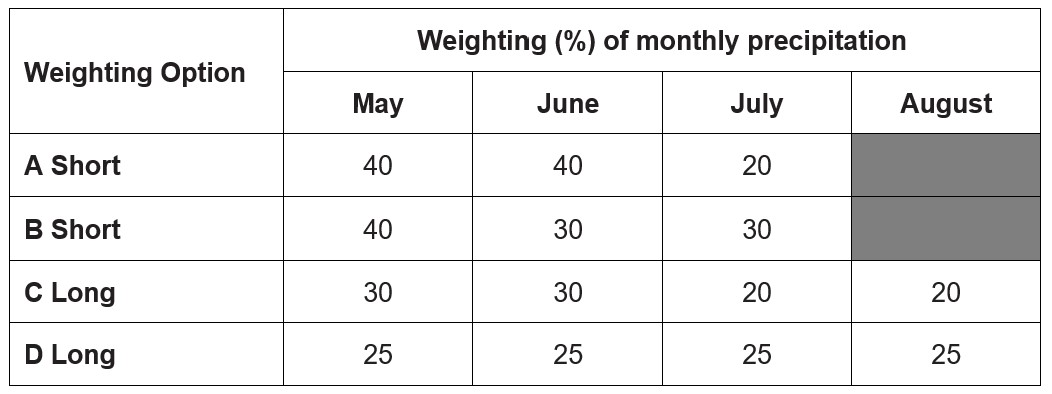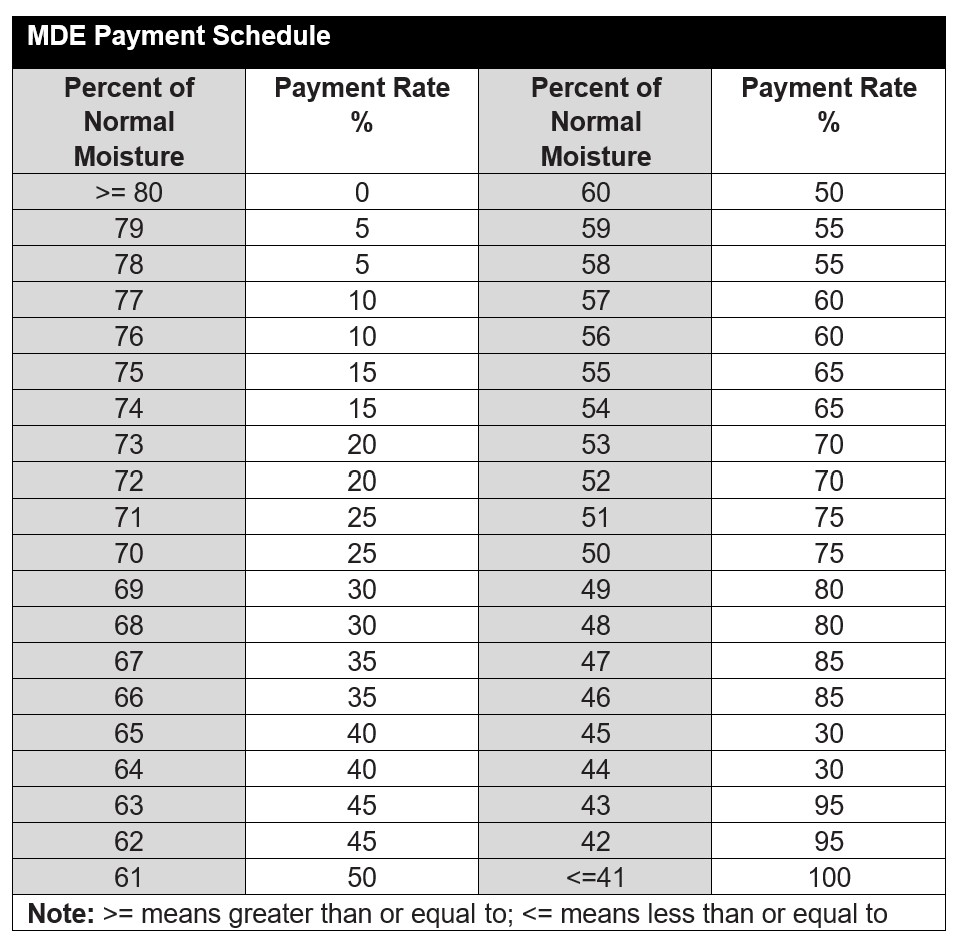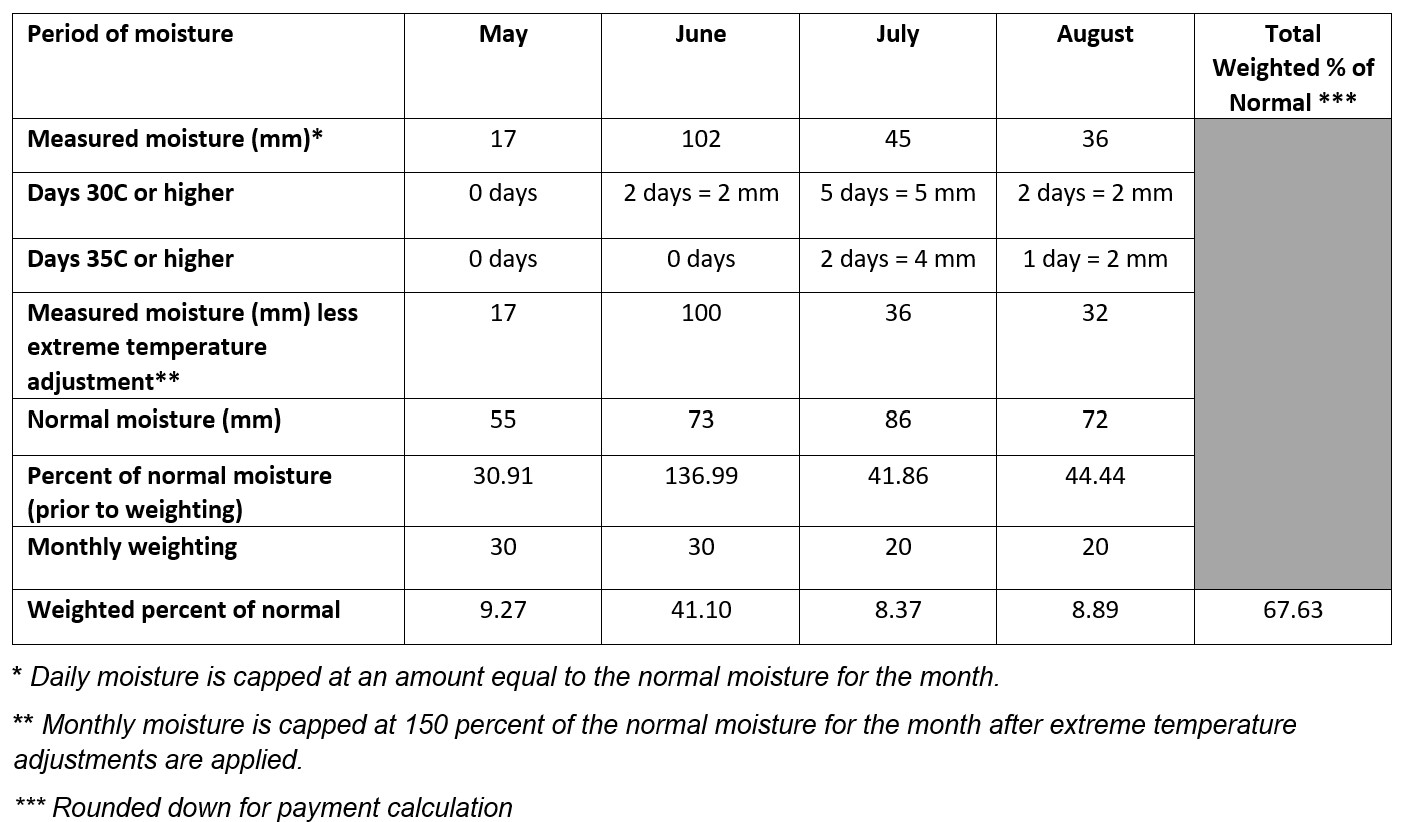Moisture Deficiency Endorsement Insuring Agreement 2024
Moisture Deficiency Endorsement Insuring Agreement
AFSC will indemnify the Insured when the Percent of Normal Moisture is less than the Threshold Moisture at the Selected Weather Station(s) for the Insured’s dryland Hay pursuant to this Insuring Agreement. This Insuring Agreement incorporates by reference, and is subject to, the Terms and Conditions and Benefits. The definitions in the Terms and Conditions will apply unless the same term is otherwise defined in this Insuring Agreement.
The Moisture Deficiency Endorsement can be purchased along with dryland Hay Insurance. This endorsement uses precipitation information from a network of weather stations across the province to reflect moisture conditions. Conditions at the weather stations may not reflect conditions on the insured fields.
“Insurable Crop” means Hay grown on non-irrigated land.
“August Moisture” is the amount of precipitation, as determined by AFSC, for the month of August, for a Selected Weather Station(s).
“Designated Peril” means lack of moisture at the Selected Weather Station(s). For greater clarity, this is the only Designated Peril under this Insuring Agreement, and the Designated Perils listed under Article 1 of the Terms and Conditions do not apply to this Insuring Agreement.
“Dollar Coverage” means 15 percent of 80 percent of the Risk Area Normal Yield for the Insurable Crop at the highest Spring Insurance Price multiplied by the number of acres insured.
“Hay” means seeded perennial tame grass, legumes or grass-legume mix crops grown for mechanical harvesting for use as livestock feed.
“July Moisture” is the amount of precipitation, as determined by AFSC, for the month of July, for a Selected Weather Station(s).
“June Moisture” is the amount of precipitation, as determined by AFSC, for the month of June, for a Selected Weather Station(s).
“May Moisture” is the amount of precipitation, as determined by AFSC, for the month of May, for a Selected Weather Station(s).
“Normal Moisture” for each Period of Moisture is the long-term average amount of precipitation, as determined by AFSC, for a Selected Weather Station(s).
“Payment Rate” means the rate of compensation at which the Insured is indemnified, as determined by AFSC.
“Percent of Normal Moisture” means, for the Selected Weather Station(s) for the current year, the sum of the May Moisture, June Moisture, July Moisture and August Moisture expressed as a percent of their respective Normal Moisture, with each Period of Moisture weighted by the Weighting Option elected by the Insured.
“Period of Moisture” is the period for which moisture is measured under this Insuring Agreement. There are four different periods: May, June, July, and August.
“Selected Weather Station” means eligible weather station(s) elected, to a maximum of three, by the Insured and approved by AFSC.
“Threshold Moisture” is the Percent of Normal Moisture for a Selected Weather Station(s) below which insurance payments begin.
“Weighting Option” is the option elected by the Insured to apply specified percentages to the Percent of Normal Moisture for each Period of Moisture.
Each Risk Area has an Area Normal Yield for each hay crop type. Eighty percent of the Area Normal Yield is used as the base yield for each Insured Crop. Dollar Coverage is determined by multiplying the base yield by 15 percent and by the Spring Insurance Price high price option for hay.
AFSC will use precipitation data provided by Alberta Government ministry responsible for Agriculture. If AFSC is not able to do the assessment due to insufficient data being provided, this Insuring Agreement will cease to be enforceable against AFSC and cease to have any effect against AFSC. AFSC will then return to the Insured all paid Premiums.
a. Spring Insurance Price: AFSC uses the high price option for each Insurable Crop type insured under Hay Insurance for this Endorsement.
a. Rates: Premium rates are set annually based upon long-term weather station data and reflect AFSC’s risk of future losses. Premium rates vary by weather station. The Insured’s Premium is calculated by multiplying the Dollar Coverage by the Insured’s share of the premium rate. If more than one weather station is elected by the Insured, the premium rate will be based on the average of the premium rates for the Selected Weather Station(s).
b. Adjustments & Discounts:
a. Application: New clients can apply for Moisture Deficiency Endorsement along with their Hay insurance Policy by the last day of February. Moisture Deficiency Endorsement may be elected with 60, 70, or 80 percent Coverage Levels by the last day of February.
b. Renewal Process: Insurance remains in effect from year to year therefore an Insured who elected Moisture Deficiency Endorsement on a Hay Insurance Policy in the previous year will be automatically renewed based upon the previous year’s information. The Insured is responsible to review their information and if changes are required, complete a Change Request form and return the form to an AFSC insurance representative by mail, fax, email, online, in person, or request changes by phone by the last day of February.
c. Length of Season: The Insured chooses the length of season that best represents pasture growth and supports their management strategies.
i. Short season option: includes precipitation from May, June and July.
ii. Long season option: includes precipitation from May, June, July and August.
d. Weighting Option: the Insured has the choice of different Weighting Options within the growing season. Based on the weighting percentages, there are four Weighting Options available to select.
e. Selected Weather Stations: The Insured can choose up to three weather stations from the network of eligible weather stations that best represent the conditions on their farm and within proximity of their land base. The Insured is not allowed to skip a weather station, and Selected Weather Station(s) are subject to approval by AFSC.
| Weighting the precipitation in each month allows you to select the Weighting Option that best reflects your area, crop type and management practices. |
a. A network of weather stations is established across the province. Rainfall for the current year is compared to historical rainfall (Normal Moisture) for the same growing period at the Selected Weather Station(s) to determine a claim.
b. Precipitation in millimeters (mm) is recorded at the Selected Weather Station(s) and is compared to the Normal Moisture in mm recorded for the same weather station(s). For each month, both the actual and normal amounts are weighted based on the Weighting Option selected. This comparison describes a ‘percentage of normal’, which, if less than the allowable Threshold Moisture percent of normal, initiates a claim payment.
c. When extreme temperatures are recorded at a Selected Weather Station(s), the following deductions will be made from the monthly recorded precipitation of the Selected Weather Station(s):
i. 1.0 mm for each day the temperature is 30 Celsius or higher;
ii. an additional 2.0 mm (3.0 mm total) for each day the temperature is 35 Celsius or higher.
d. Precipitation used to calculate a claim payment for the current year is limited by the following rules:
i. Daily recorded precipitation at a Selected Weather Station is capped at an amount equal to the Normal Moisture for the month;
ii. Monthly recorded precipitation at a Selected Weather Station is capped at an amount equal to one and a half times the Normal Moisture for that month;
iii. Daily precipitation measurements under 1.0 mm will be considered 0.0 mm, and will not be included in determining the precipitation for the month.
a. Only dryland Hay acres in Alberta insured under a Hay insurance Policy are insurable under this Insuring Agreement.
b. Once elected, all acres of dryland Hay including alfalfa, legume and grass that are insured under the Hay Insurance Policy are insured under this Insuring Agreement.
Moisture Deficiency Endorsement is not available for irrigated alfalfa.
A person who has a direct or indirect conflict of interest with precipitation data provided at one or more Selected Weather Stations(s) used for Moisture Deficiency Endorsement shall not purchase insurance based upon the data from the Selected Weather Station(s) for which person may have a conflict. A person may be in a conflict of interest if the person is involved in providing, either directly or indirectly, weather data for a weather station.
a. Moisture Deficiency Endorsement is not available at the 50 percent Coverage Level.
b. The Variable Price Benefit is not available under this Insuring Agreement.
If a reporting deadline date falls on a weekend, the deadline will be extended to the next Business Day.
a. The Insured is not required to submit a Notice of Loss to initiate a claim for lack of moisture at the Selected Weather Station(s).
a. Upon calculation of an assessment, AFSC will serve the Insured with a Statement of Loss.
b. If the assessment results in no payment, the Statement of Loss will be considered to be the final Statement of Loss for the claim by the Insured. No further Statement of Loss will be issued by AFSC.
Losses are paid when accumulated precipitation at the Selected Weather Station(s) falls below the Normal Moisture for the Selected Weather Station(s) according to the payment schedule.
a. An Indemnity is calculated as follows:
i. [Dollar Coverage x Payment Rate]
The maximum Indemnity payable is 100 percent of the Dollar Coverage.
b. The Payment Rate will be based on the average of the Payment Rates for the Insured’s Selected Weather Station(s).
i. The Payment Rate for the Selected Weather Station(s) will be zero when the Percent of Normal Moisture is equal to or more than the Threshold Moisture.
ii. For each two percent decrease that the Percent of Normal Moisture is below the Threshold Moisture, the Payment Rate will increase by five percent.
c. Except at the discretion of AFSC, no changes will be made to the May Moisture, June Moisture, July Moisture or August Moisture values after an Indemnity has been paid.
May 31, 2024: An error has been identified in the MDE Payment Schedule (above). The table shows for the Percent of Normal Moisture of 44 and 45, the Payment Rate will be ’30’, whereas the actual Payment Rate for 44 and 45 Percent of Normal Moisture is ‘90’ as below.
Indemnity: Calculation Example for Moisture Deficiency Endorsement
Assumption: Insured elected Weighting Option C Long, coverage is $20 per acre on 200 acres of Hay for $4,000 total coverage.
Coverage is weighted across the months of May to August: 30% May; 30% June; 20% July; 20% August
Example of weather station information
a. Calculate the monthly percent of normal using the information in the table above.
Percent of normal = actual moisture less extreme temperature adjustment / normal moisture:
i. Percent of normal for May = 17 / 55 x 100% = 30.91%
ii. Percent of normal for June = 100 / 73 x 100% = 136.99%
iii. Percent of normal for July = 36 / 86 x 100% = 41.86%
iv. Percent of normal for August = 32 / 72 x 100% = 44.44%
b. Calculate the weighted percent of normal using the determined percent of normal multiplied by the weighting percentage for option C.
Weighted percent of normal = Percent of normal x Monthly weighting:
i. Weighted percent of normal for May = 30.91 x 30% = 9.27%
ii. Weighted percent of normal for June = 136.99 x 30% = 41.10%
iii. Weighted percent of normal for July = 41.86 x 20% = 8.37%
iv. Weighted percent of normal for August = 44.44 x 20% = 8.89%
v. Total weighted percent of normal
= Weighted percent of normal for (May + June + July + August) = 67.63%
c. Calculated the indemnity using the payment rate corresponding to the total weighted percent of normal, rounded down for payment calculations, from the MDE payment schedule, multiplied by the total dollar coverage:
i. Total weighted percent of normal = 67%, corresponds to 35% payment rate;
ii. $4,000 x 35% = $1,400
Precipitation measurements that are less than 1.0 mm will be considered 0.0 mm, and will not be included in determining the precipitation for the month
Disclaimer: Daily precipitation received from Alberta Government ministry responsible for Agriculture will be rounded to the nearest 0.1 mm.








